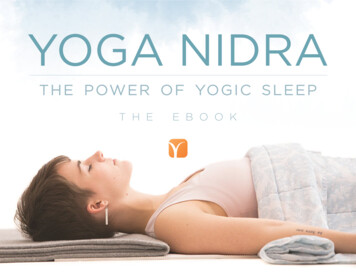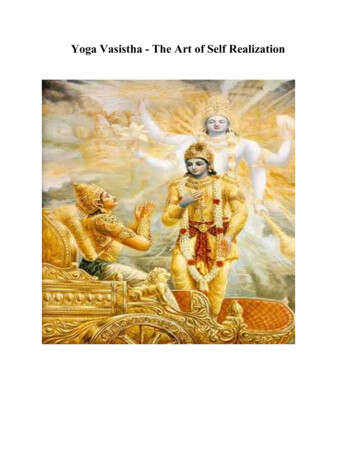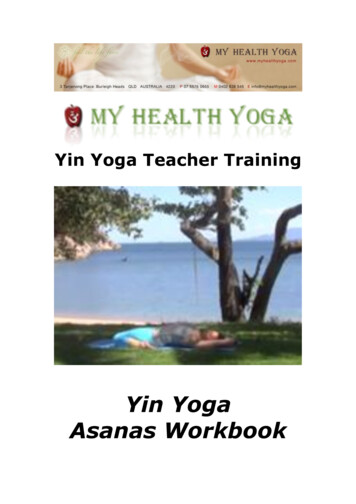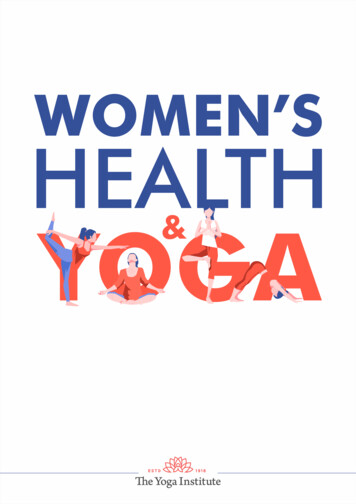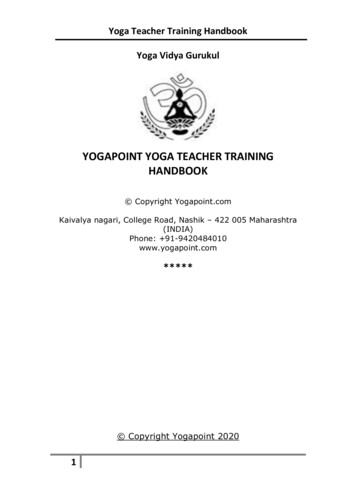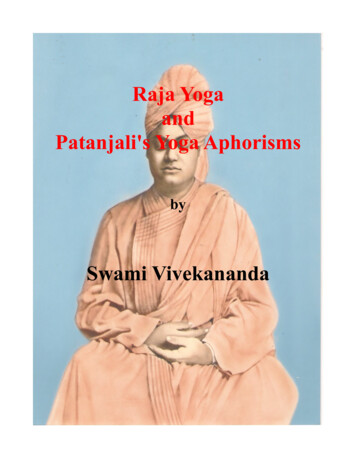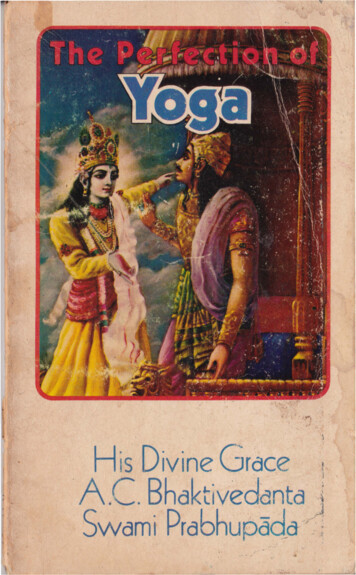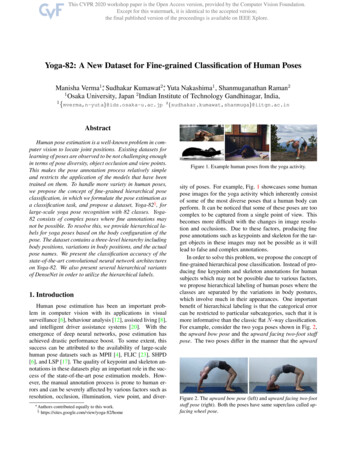
Transcription
Yoga-82: A New Dataset for Fine-grained Classification of Human PosesManisha Verma1 , Sudhakar Kumawat2 , Yuta Nakashima1 , Shanmuganathan Raman21Osaka University, Japan 2 Indian Institute of Technology Gandhinagar, India,1{mverma,n-yuta}@ids.osaka-u.ac.jp 2 an pose estimation is a well-known problem in computer vision to locate joint positions. Existing datasets forlearning of poses are observed to be not challenging enoughin terms of pose diversity, object occlusion and view points.This makes the pose annotation process relatively simpleand restricts the application of the models that have beentrained on them. To handle more variety in human poses,we propose the concept of fine-grained hierarchical poseclassification, in which we formulate the pose estimation asa classification task, and propose a dataset, Yoga-82§ , forlarge-scale yoga pose recognition with 82 classes. Yoga82 consists of complex poses where fine annotations maynot be possible. To resolve this, we provide hierarchical labels for yoga poses based on the body configuration of thepose. The dataset contains a three-level hierarchy includingbody positions, variations in body positions, and the actualpose names. We present the classification accuracy of thestate-of-the-art convolutional neural network architectureson Yoga-82. We also present several hierarchical variantsof DenseNet in order to utilize the hierarchical labels.1. IntroductionHuman pose estimation has been an important problem in computer vision with its applications in visualsurveillance [6], behaviour analysis [12], assisted living [8],and intelligent driver assistance systems [20]. With theemergence of deep neural networks, pose estimation hasachieved drastic performance boost. To some extent, thissuccess can be attributed to the availability of large-scalehuman pose datasets such as MPII [4], FLIC [23], SHPD[6], and LSP [17]. The quality of keypoint and skeleton annotations in these datasets play an important role in the success of the state-of-the-art pose estimation models. However, the manual annotation process is prone to human errors and can be severely affected by various factors such asresolution, occlusion, illumination, view point, and diver Authors§contributed equally to this ure 1. Example human poses from the yoga activity.sity of poses. For example, Fig. 1 showcases some humanpose images for the yoga activity which inherently consistof some of the most diverse poses that a human body canperform. It can be noticed that some of these poses are toocomplex to be captured from a single point of view. Thisbecomes more difficult with the changes in image resolution and occlusions. Due to these factors, producing finepose annotations such as keypoints and skeleton for the target objects in these images may not be possible as it willlead to false and complex annotations.In order to solve this problem, we propose the concept offine-grained hierarchical pose classification. Instead of producing fine keypoints and skeleton annotations for humansubjects which may not be possible due to various factors,we propose hierarchical labeling of human poses where theclasses are separated by the variations in body postures,which involve much in their appearances. One importantbenefit of hierarchical labeling is that the categorical errorcan be restricted to particular subcategories, such that it ismore informative than the classic flat N -way classification.For example, consider the two yoga poses shown in Fig. 2,the upward bow pose and the upward facing two-foot staffpose. The two poses differ in the manner that the upwardFigure 2. The upward bow pose (left) and upward facing two-footstaff pose (right). Both the poses have same superclass called upfacing wheel pose.
Table 1. Comparison of human pose datasets.DatasetsMPII [4]LSP [17]LSP-Ext. [18]FLIC [23]SHPD MoviesSurveillanceBingTarget g two-foot staff pose puts headstand together with theupward bow pose. Apart from this, both the poses havemany similarities such as the way in which the back is bent(wheel pose), the orientation of faces, and the placement oflegs. Therefore, both these poses can be put in a single superclass pose called up-facing wheel pose. An advantage ofthis type of label structure is that, once the network learnsthat it is a type of up-facing pose, it will not confuse it withany down-facing poses such as the cat-cow pose which havea similar wheel type structure. Further separation of theclasses at the lowest level will help the network to focuson specific parts of the body. For example, the headstandpart of the upward facing two-foot staff pose.In this work, building on the concept of fine-grained hierarchical pose classification (as discussed above), we propose a large-scale yoga dataset. We choose yoga activitysince it contains a wide variety of finely varying complexbody postures with rich hierarchical structures. This datasetcontains over 28.4K yoga pose images distributed among 82classes. These 82 classes are then merged/collapsed basedon the similarities in body postures to form 20 superclasses,which are then further merged/collapsed to form 6 superclasses at the top level of the hierarchy (Fig. 3). To the bestof our knowledge, Yoga-82 is the first dataset that comeswith class hierarchy information. In summary, the maincontributions of this work are as follows. We propose the concept of fine-grained hierarchical pose classification and propose a large-scale posedataset called Yoga-82, comprising of multi-level classhierarchy based on the visual appearance of the pose. We present performance evaluation of pose recognition on our dataset using well-known CNN architectures. We present modifications of DenseNet in order to utilize the hierarchy of our dataset for achieving betterpose recognition.Related work. Human pose estimation has been an important problem in computer vision and many benchmarkdatasets have been proposed in the past. Summary of someof the most commonly used human pose datasets is presented in Table 1. Many of these datasets are collectedfrom the sources such as online videos, movies, images,sports videos, etc. Some of them provide rich label information but lack in human pose diversity. Most of the posesin these datasets ([4], [6], and [23]) are of standing, walking, bending, sitting, etc. and not even close to comparisonwith complex yoga poses (Fig. 1). Chen et al. [6], recentlyobserved that the images considered for annotations are ofvery high quality with large target objects. For example,in the MPII dataset [4], around 70% of the images consistsof human objects with height over 250 pixels. Thus, without much diversity in human poses and target object size inthese datasets, they can not meet the high-quality requirements of applications such as behaviour analysis. Our proposed Yoga-82 dataset is very different from these datasetsin the two aspects discussed above. We choose yoga activity, which we believe consists of some of the most diverseand complex examples of human poses. Furthermore, theimages considered from the wild are with different viewpoints, illumination conditions, resolution, and occlusions.Few works have been done on yoga pose classification forapplications such as self training [5, 26, 21, 15]. Howeverthese works involve yoga dataset with a less number of images or videos and does not consider vast variety of poses.Hence, they lack in generalization and are far from complexyoga pose classification.2. The Yoga-82 DatasetData Acquisition. The dataset contains yoga pose imagesdownloaded from web using the Bing search engine. Thetaxonomy about yoga poses (name and appearance) is collected from various websites and books [16, 19, 2, 1]. BothSanskrit and English names of yoga poses were used tosearch for images and the downloaded images were cleanedand annotated manually. Every image contains one or morepeople doing the same yoga pose. Furthermore, imageshave poses captured from different camera view angles.There are a total of 82 yoga pose classes in the dataset.The dataset has a varying number of images in each classfrom 64 (min.) to 1133 (max.) with an average of 347 images per class. Some of the images are downloaded from aspecific yoga website. Hence, they contain only yoga posewith clean background. However, there are many imageswith random backgrounds (e.g., forest, beach, indoor, etc.).Some images only contain silhouette, sketch, and drawingversion of yoga poses and they were kept in the dataset asyoga pose is more about the overall structure of body andnot the texture of clothes and skin. For the sake of easinessin understanding and readability, here we use only Englishnames for the yoga poses. However, Sanskrit names areavailable as well in the dataset for reference.Label Hierarchy and Annotation. Existing pose datasets(Table 1) available publicly for evaluation do not imposehierarchical annotations. Hierarchical annotations can bebeneficial for part-based learning in which few parts of
BalancingForwardbendSide bendOthersNormal1(legs infront)Normal2(legs rdbend6.Dolphin7.Downwarddog8.Inteseside stretch9.Half moon10.Extendedtriangle11.Extendedside angle12.Gate13.Warrior I14.ReverseWarrior15.Lowlunges16.Warrior II17.Warrior III18.Lord ofdance19.Standingbig-toe land24.Staff25.Noose26.Cow face27.Hero andthunderbolt28.Bhardwaja'stwist29.Half lord ofthe dLegsstraight upLegsbend47.Handstand 52. Plow48.Headstand s up 56.Happy baby57.Reclininghand-to-big-toe58.Wind relieving59.Recliningcobbler60.Reclining hero61.Yogic ppyForwardbendTwistFrontSide32.Head aniyaWheelSidefacing67.Siderecliningleg lift68.SideplankPlankbalanceUp- facing69.Dolphinplank70.Lowplank (fourlimbedstaff71.Plank72.Peacock73.Upward bow74.Upwardfacing two- footstaff75.Upwardplank76.Pigeon77.Bridge78.Wild things79.CamelDownfacingOthers80.Cat-cow 81. Boat82. BowFigure 3. Yoga-82 dataset label structure. Hierarchical class names at level 1, 2, and 3.the network will learn features based on the hierarchicalclasses. Many hierarchical networks have been observed toperform better as compared to their baseline CNN models[28, 9]. Hierarchical annotations are beneficial for learningthe network as they provide rich information to users notonly about the pose names but also about the body postures(standing, sitting, etc.), the effect on the spine (e.g., forwardbend, back bend in wheel pose, etc.), and others (e.g. downfacing or up-facing).Our labels are with a three-level hierarchical structurewhere the third level is a leaf node (yoga pose class). Thereare 6, 20, and 82 classes in the first-, second-, and third-levels, respectively as illustrated in Fig. 3. References forthese classes have been collected from websites and books[24, 16, 19, 2, 1, 3]. There is no established hierarchy inyoga poses. However, standing, sitting, inverted, etc. arewell defined as per their configuration. In this work, wehave taken guidelines from [24, 16, 19, 2, 1] in order to define the first level classes and defined a new class (wheel)based on the posture of the subject’s body in a certain pose.The second level further divides the first level classes intodifferent classes as per subject’s body parts configuration.However, it is hard to define 82 leaf classes in 6 superclasses perfectly. Yet, we have made an attempt to briefly
(a) Inverted poses.(b) Plank poses.(a)(b)(c)(c) Standing poses(d)(e)Figure 4. Different variations of the same pose in one class (a)Extended triangle pose and revolved triangle pose, (b) Hero poseand thunderbolt pose, (c) Upward bow pose and its variation, (d)Fish pose and its variation, and (e) Side spilt and front split pose.describe the 6 first level classes as follows.Standing: Subject is standing while keeping their bodystraight or bending. Both or one leg will be on the ground.When only one leg is on the ground, the other leg is in aireither held by one hand or free.Sitting: Subject is sitting on the ground. Subject’s hip willbe on ground or very close to the ground (e.g., garlandpose).Balancing: Subject is balancing their body on palms. Boththe palms are on ground and the rest of the body is in air.Subject’s body is not in the inverted position.Inverted: Subject’s body is upside down. Lower body iseither in air or close to the ground (e.g., plow pose).Reclining: Subject’s body is lying on the ground. Eitherspine (upward facing) or stomach (downward facing) orside body (side facing) touching or very near to the ground,or subject’s body is in 180 angle (approximately) alongside ground (e.g, plank poses).Wheel: Subjects body is in half circle or close to half circleon ground. In upward facing or downward facing poses,both the palm and the feet will touch the ground. In otherscategory, either only hip or stomach will touch the ground;(d) Balancing posesFigure 5. Some example of different classes in very similar appearances.the other body parts will be in air.All the class levels are shown in Fig. 3. The class namesand their images are based on the body configuration. Forexample, forward bend is a second-level class in both standing and sitting. As it is clear from its name, this classincludes poses where the subject needs to bend forwardwhile standing or sitting. Similar names are given to theother second-level classes. The poses that do not fit in anysecond-level classes are kept in others (standing), twist (sitting), normal1 (sitting), normal2 (sitting), etc.Analysis over our Dataset. Some of the poses have variations of their own. For example, extended triangle poseand revolved triangle pose, head-to-knee pose and revolvedhead-to-knee pose, hero pose, reclining hero pose, etc.These poses are kept in the same class or different classesin the third level based on the differences in their visualappearances. For example, extended triangle pose and revolved triangle pose (Fig. 4(a)) are in the same class, whilehead-to-knee pose and revolved head-to-knee pose are indifferent classes.Some completely different poses (e.g. hero pose andthunderbolt pose, side spilt pose and front split pose, etc.)are kept in same third-level classes as they appear to be very
Table 2. Performance of the state-of-the-art architectures on Yoga-82 using third-level class (82 10150101121169201888850101# Params23.70 M42.72 M23.68 M42.69 M7.03 M12.6 M18.25 M3.29 M2.33 M23.15 M42.29 MModel size190.4 MB343.4 MB190.3 MB343.1 MB57.9 MB103.4 MB149.1 MB26.7 MB19.3 MB186.1 MB340.2 3086.8188.5086.4284.76Table 3. Classification performances of our three variants. L1, L2, and L3 stand for the first-, second-, and third-level classification,respectively.Network# ParamsVariant 1Variant 2Variant 318.27 M18.27 M22.59 MTop-1L183.8489.8187.20L285.1084.5984.42similar to each other. For example, hero pose and thunderbolt pose (Fig. 4(b)) have a minute difference that legs tobe placed near the thighs and under the thighs, respectively.Other class separations were carefully made using suggestions of three of the authors based on the appearance of theposes.Our dataset is very challenging in terms of similaritybetween different classes. There are many classes at thethird level that are very similar to each other that are treatedas different poses. For example, inverted poses (level 2)has poses that differ from each other if the subject is ininverted position and balancing their body up straight onhands (handstand pose), head (headstand pose), or forearms (feathered peacock pose) as shown in Fig. 5(a). Similarly, plank poses differ from each other based on plank’sheight from the ground and whether its on palms or forearms (Fig. 5(b)). Few similar poses are shown in Fig. 5.These poses make the dataset very challenging as this is notcovered in any previous pose datasets [5].3. ExperimentsWe divide our experiments into two parts. In the firstpart, we conduct benchmark experiments on the Yoga-82dataset. In the second part, we present three CNN architectures that exploit the class hierarchy in our Yoga-82 datasetto analyze the performance using hierarchical labels.3.1. Benchmarking Yoga-82 DatasetWe evaluate the performance of several popular CNNarchitectures on the Yoga-82 dataset that have 7.0897.0397.28L393.4792.8492.66achieved state-of-the-art accuracies on image recognitiontasks on the ImageNet [7] dataset.Benchmark models. Table 2 gives a comprehensive list ofnetwork architectures that we used for benchmarking ourYoga-82 dataset. They are selected such that they differ instructures, depth, convolutional techniques, as well as computation and memory efficiencies. For example, ResNet[10, 11] and DenseNet [14] differ in the manner the skipconnections are applied. MobileNet [13, 22] uses separable convolutions for better computational and memory efficiency. ResNext [25] uses group convolutions for betterperformance and reduces space-time complexity.Experimental protocol and setting. All our experimentswere conducted on a system with Intel Xeon Gold CPU(3.60 GHz 12), 96 GB RAM, and an NVIDIA QuadroRTX 8000 GPU with 48 GB memory. We used Keras withTensorflow backend as the deep learning framework. Fortraining the networks, we used stochastic gradient descent(SGD) with momentum 0.9. We started with a learning rateof 0.003 and decreased it by the factor of 10 when the validation loss plateaus. All weights were initialized with theorthogonal initializer. We did not apply any data augmentation techniques on the input images. All images were resized to 224 224, before feeding into the networks. Wesplit our dataset into training and testing sets, which contain21009 and 7469 images, respectively. As mentioned earlier,we provide train-test splits of the dataset for consistent evaluation and fair comparison over the dataset in future.Results. The results of the benchmark experiments areshown in Table 2. Both the top-1 and top-5 classification accuracies are reported. We observe that deeper net-
GAvgPool1 conv, 128Dense layer 32DenseBlock 4Dense layer 1AvgPool 2/21 conv, 512Dense layer 48DenseBlock 3Dense layer 1AvgPool 2/21 conv, 256Dense layer 12Dense layer 11 conv, 128Dense layer 6AvgPool 2/2DenseBlock 2DenseBlock 1Dense layer 1MaxPool 3/2(a) 224 2247 conv, 64/2DenseNet201FC 82FC 20GAvgPool1 conv, 128Dense layer 32DenseBlock 4Dense layer 1AvgPool 2/21 conv, 512Dense layer 48DenseBlock 3Dense layer 1AvgPool 2/21 conv, 256Dense layer 12AvgPool 2/21 conv, 128Dense layer 6Dense layer 1DenseBlock 2DenseBlock 1Dense layer 1MaxPool 3/2(b) 224 2247 conv, 64/2FC 6FC 82FC 20Dense layer 32Dense layer 13 conv, 321 conv, 1283 conv, 321 conv, 128GAvgPoolFC 82FC 20DenseBlock 5Dense layer1 conv, 128Dense layer 32DenseBlock 4Dense layer 1AvgPool 2/21 conv, 512Dense layer 48DenseBlock 3Dense layer 1AvgPool 2/21 conv, 256Dense layer 12Dense layer 11 conv, 128Dense layer 6AvgPool 2/2DenseBlock 2DenseBlock 1Dense layer 1224 224MaxPool 3/2(c)7 conv, 64/2FC 6FC 6Figure 6. DenseNet-201 modified hierarchical architectures.works have a clear edge over their shallower versions. Forexample, 101-layer ResNet architecture (ResNet-101) outperformed its 50-layer variant (ResNet-50). Furthermore,deeper networks with dense skip connections, such as theDenseNet architectures, performed better than the networkswith sparse skip connections. DenseNet-201 gives the bestperformance, achieving top-1 classification accuracies of74.91% .3.2. Hierarchical ArchitecturesOur dataset, Yoga-82, provides a rich hierarchical structure in the labels, which can be utilized in order to enhancethe performance of pose recognition. Based on [28], wemodify Densenet-201 architecture to make use of the structure. That is, due to the hierarchical structure, label prediction in any level can be deducted from the third-level prediction results. However, since the hierarchy is based muchon visual similarity between different poses, training withupper-level labels may help lower-level boost the predictionin lower-level label, and vice versa.Variant 1. In this variant, hierarchical connections areadded in DenseNet-201 after DenseBlock 2 and Dense-Block 3 for class level 1 (6 classes) and class level 2 (20classes), respectively, as shown in Fig. 6(a). Coarser classesare classified at the middle layers and finer classes are at theend layers of the network. The intuition behind this variantis to utilize hierarchy structure in the dataset. Initial-to-midlayers learn to classify the first level and the details in theinput image is passed on to next layers for the second-levelclassification, and so on. Layers shared by all three levels(up to DenseBlock 2) learn basic structure of pose and further layers refine it for specific details. The branch for thefirst-level classification applies batch normalization and theReLU activation, followed by global average pooling. Thesame applies to the branch for the second-level classification. The main branch is for the third-level classificationwith 82 classes. Softmax-cross entropy loss is computedfor all three levels and weighted sum is evaluated as the final loss as follows:L 3Xi 1wiNiXtij log(yij ),(1)j 1where Ni (i 1, 2, 3) is the number of labels in level l, i.e.,6, 20, and 82 for i 1, 2, and 3, respectively. tij {0, 1}is ground truth for label j of level l. yij is the output of the
Figure 7. Activation maps learned using variant 2.softmax layer. wi is the weight for level i. All weights areset to one as we consider that all levels are equally important.Variant 2. In variant 1, the first-level classifier doeshave access to only DenseBlock 1 and DenseBlock 2 thatcomprises of 6 and 12 dense layers, respectively, whereasDenseBlock 3, which classifies level 2, has 48 dense layers. Hence, the accuracy of the first-level classifier may bedegraded in variant 1 because of insufficient representationcapability. Since our focus is to classify images into classesin all three levels correctly, we make branches for the firstand second-level classifiers from the same position (Fig. 6),so that the first-level classifier can have more representationcapability. We classify both levels after DenseBlock 3 asillustrated in Fig. 6(b). Batch normalization, the ReLU activation, global average pooling, and loss function are thesame as variant 1.Variant 3.Another attempt to classify all three levelsequally is made in variant 3. We employ a similar architecture as variant 1, except that we add DenseBlock 5 with 32dense layers for the first-level classifier branch (Fig. 6(c)).This variant gives more trainable parameters to the firstlevel classifiers while keeping the hierarchical structure ofnetwork. This variant increases the number of parameterscompared to the others.Results and Discussion. The performances of all threevariants are presented in Table 3 along with the numbersof parameters. All three variants stem from DenseNet-201and thus the numbers of parameters differ only because ofthe addition of DenseBlock 5 in variant 3. Clearly, the hierarchical structures boosted the performances. As shown inTables 2 and 3, the accuracy of the third-level classifier (82classes) was boosted from 74.91% to 79.35% with hierarchical connections added in DenseNet-201.We can see that the third-level classifiers (L3 in Table 3)give similar accuracies varying within 1% in all three variants. In contrast, we see huge variations in the accuracyof the first-level classifier. From these results, we may saythat the performance depends more on the number of layersor the parameters responsible for a certain level classifieras well as on the number of classes. For example, variant 1 uses two DenseBlocks (6 12 dense layers) for thefirst-level classification and three DenseBlocks (6 12 48dense layers) for the second-level classification. This hugegap between the numbers of parameters used for the firstand second-level classification may cause the difference inperformances. This gap is reduced with variant 2 whosefirst- and second-level classifiers branch at the same point(i.e., after DenseBlock 3). As expected, the accuracy of thefirst level is less than that of the second level 2 and the accuracy of the second level is less than that of the third level.Similarly, variant 3 has extra layers added for the first-levelclassification. Hence, the accuracies decrease in the orderof the first level to the third level classifiers. Variant 3 increases the performance at the cost of additional parametersin the network. In conclusion, variant 2 can balance well.In Fig. 7, we present the class activation maps obtainedfrom variant 2 using [27]. It can be observed that our modelresponded to the person doing a certain pose. Furthermore,we observe that, for a particular pose, the model focuseson one or specific parts of the body. For example, for eagle pose (Fig. 7, second column), the model focused on theconfiguration of the legs of the person.
4. ConclusionIn this work, we explored human pose recognition froma different direction by proposing a new dataset, Yoga-82,with 82 yoga pose classes. We define a hierarchy in labels by grasping the knowledge of body configurations inyoga poses. In particular, we present a three-level hierarchical label structure consisting of 6, 20, and 82 classesin the first to third levels. We conducted extensive experiments using popular state-of-the-art CNN architectures andreported benchmark results for the Yoga-82 dataset. Wepresent modified DenseNet architecture to utilize the hierarchy labels and get a performance boost as compared to theflat n label classification. It is evident that hierarchy information provided with dataset improves the performance because of additional learning supervision. It is visible fromresults that there is sufficient room for accuracy improvement in yoga pose classification. In future, we will focus onadding explicit constraints among predicted labels for different class levels.References[1] Wikipedia: List of asanas. https://en.wikipedia.org/wiki/List of asanas. 2, 3[2] Yoga journal.https://www.yogajournal.com/poses. 2, 3[3] Yoga sequence builder. https://www.tummee.com/.3[4] Mykhaylo Andriluka, Leonid Pishchulin, Peter Gehler, andBernt Schiele. 2d human pose estimation: New benchmarkand state of the art analysis. In CVPR, pages 3686–3693,2014. 1, 2[5] Hua-Tsung Chen, Yu-Zhen He, Chun-Chieh Hsu, Chien-LiChou, Suh-Yin Lee, and Bao-Shuh P Lin. Yoga posturerecognition for self-training. In MMM, pages 496–505, 2014.2, 5[6] Qiuhui Chen, Chongyang Zhang, Weiwei Liu, and DanWang. SHPD: Surveillance human pose dataset and performance evaluation for coarse-grained pose estimation. InICIP, pages 4088–4092, 2018. 1, 2[7] Jia Deng, Wei Dong, Richard Socher, Li-Jia Li, Kai Li,and Li Fei-Fei. Imagenet: A large-scale hierarchical imagedatabase. In CVPR, pages 248–255, 2009. 5[8] Philipe Ambrozio Dias, Damiano Malafronte, HenryMedeiros, and Francesca Odone. Gaze estimation for assisted living environments. In WACV, pages 290–299, 2020.1[9] Ruigang Fu, Biao Li, Yinghui Gao, and Ping Wang. CNNwith coarse-to-fine layer for hierarchical classification. IETComput. Vis., 12(6):892–899, 2018. 3[10] Kaiming He, Xiangyu Zhang, Shaoqing Ren, and Jian Sun.Deep residual learning for image recognition. In CVPR,pages 770–778, 2016. 5[11] Kaiming He, Xiangyu Zhang, Shaoqing Ren, and Jian Sun.Identity mappings in deep residual networks. In ECCV,pages 630–645, 2016. 5[12] Michael B Holte, Cuong Tran, Mohan M Trivedi, andThomas B Moeslund. Human pose estimation and activity recognition from multi-view videos: Comparative explorations of recent developments. IEEE J. Sel. Topics SignalProcess., 6(5):538–552, 2012. 1[13] Andrew G Howard, Menglong Zhu, Bo Chen, DmitryKalenichenko, Weijun Wang, Tobias Weyand, Marco Andreetto, and Hartwig Adam. Mobilenets: Efficient convolutional neural networks for mobile vision applications. arXivpreprint arXiv:1704.04861, 2017. 5[14] Gao Huang, Zhuang Liu, Laurens Van Der Maaten, and Kilian Q Weinberger. Densely connected convolutional networks. In CVPR, pages 4700–4708, 2017. 5[15] Muhammad Usama Islam, Hasan Mahmud, Faisal BinAshraf, Iqbal Hossain, and Md Kamrul Hasan. Yoga posture recognition by detecting human joint points in real timeusing microsoft kinect. In R10 HTC, pages 668–673, 2017.2[16] Bellur Krishnamukar Sundara Iyengar. Light on yoga. NewYork: Schocken Books, 1965. 2, 3[17] Sam Johnson and Mark Everingham. Clustered pose andnonlinear appearance models for human pose estimation. InBMVC, volume 2, page 5, 2010. 1, 2[18] Sam Johnson and Mark Everingham. Learning effective human pose estimation from inaccurate annotation. In CVPR,pages 1465–1472. IEEE, 2011. 2[19] Leslie Kaminoff and Amy Matthews. Yoga anatomy. HumanKinetics, 2011. 2, 3[20] Manuel Martin, Stephan Stuehmer, Michael Voit, and RainerStiefelhagen. Real time driver body pose estimation for novelassistance systems. In ITSC, pages 1–7. IEEE, 2017. 1[21] Sen Qiao, Yilin Wang, and Jian Li. Real-time human gesturegrading ba
yoga pose classification. 2. The Yoga-82 Dataset Data Acquisition. The dataset contains yoga pose images downloaded from web using the Bing search engine. The taxonomy about yoga poses (name and appearance) is col-lected from various websites and books [16, 19, 2, 1]. Both Sanskrit and English names of yoga poses were used to

